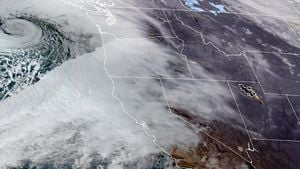Winter has wrapped its chilly arms around Pune, but for many residents, the seasonal change isn't just about cozy sweaters and warm tea. Instead, it's about dealing with deteriorated air quality levels, marked officially recently as 'poor'—a category classified when the Air Quality Index (AQI) reaches 205, the first such dip since Diwali. Experts are highlighting multiple causes for this souring situation, ranging from unexpected weather patterns to celebratory firecrackers.
Residents woke up last Saturday to find themselves enveloped by visibility-reducing haze, the result of pollutants accumulating near the ground. A combination of cold temperatures, excessive bonfire use—pursued out of necessity—and post-election celebrations, including the widespread use of firecrackers, have left many questioning the very air they breathe.
Weather phenomena are playing their part too; temperature inversion is common during the winter months, where cold air near the ground is trapped beneath warmer air above. This layer creates a barrier, marginalizing pollutants to rather stay put, instead of dispersing upwards. Essentially, pollutants are trapped, mixing with moisture, contributing to visible fog and haze pollution. Hence, as temperatures dip during the night, the stagnation of warmer air leads to concentrated pollution, which heightens health hazards.
Factors Contributing to Deteriorated Air Quality
Let’s break it down: the key contributors to Pune’s air woes include:
- Night Bonfires: With the temperatures plunging toward the chilly end of the scale, many residents have turned to burning wood or other combustible materials outdoors to keep warm, releasing particulate matter (PM) and other pollutants directly back onto their streets.
- Election Celebrations: The excitement of post-election festivities means firecrackers lighting up the night sky caused yet another spike in pollution levels, significantly burdening air quality.
- Cold Weather: It’s more than just discomfort; the icy snaps observed have caused stubborn air pollutants to cling closer to the ground, creating smog and making it more difficult to breathe.
The various factors compound each other adversely; the more bonfires and firecracker explosions there are, the worse the air quality becomes, leaving many residents gasping for cleaner air.
Health Advisory and Precautions
Given the AQI readings, health experts are advising those living within Pune to limit outdoor activities, particularly during the damp early mornings and late evenings when the pollution tends to peak. Particularly vulnerable are children, the elderly, and anyone with pre-existing respiratory conditions, like asthma or bronchitis. Notably, many are urged to resort to air purifiers indoors and if venturing outside—N95 masks are recommended to filter harmful pollutants.
The silver lining? Meteorologists predict daytime temperatures might help—at least somewhat—as they typically allow pollutants to disperse. Authorities suggest more substantial actions can be taken, like consuming adequate fluids and maintaining healthy diets to shield against pollution’s negative impact.
Moving Forward
While promises of improved air quality rise throughout the day, experts express concern about the potential for poor air quality to linger if current trends do not change significantly. Local officials are calling for more environmentally friendly alternatives, urging residents to forego bonfires and fireworks. Collective efforts to explore cleaner heating methods could drastically improve air quality.
But Pune is not isolated; the air quality issues extend deep throughout northern India, where cities like Chandigarh are grappling with levels exceeding WHO safety recommendations by over 15 times for continuous weeks. “When I stepped out of my house, it felt like I was inhaling smoke,” shared Imran Ahmed Ali, who experienced respiratory discomfort exacerbated by worsening seasonal air quality.
Remarkably, pollution is not just confined to metropolitan areas either; many layers of invisible and toxic pollutants are now infiltrated across villages and small towns, with members of the community unaware of rising dangers outside their doors.
The Broad Picture of Pollution
According to the Swiss firm IQAir, the toxic challenge remains rampant, with eight of the ten most polluted cities worldwide being located within the Indo-Gangetic plains—regions characterized by dense populations where hundreds of millions reside. This stretch encompasses vast areas within northern and eastern India, as well as plains reaching Pakistan and Nepal.
This problem isn’t merely seasonal; the underlying issues stem from construction activities, vehicular emissions, industrial waste, and stubble burning—all typical contributors to the compounded pollution crisis.
Experts are emphasizing how the geophysical geography of the Indo-Gangetic region compounds the issue even more. The hilly perimeter around the plains restricts airflow and traps pollutants, creating conditions ripe for stagnant air and accumulating toxins at ground level.
At this point, indications are bleak. The connection between pollution and severe health risks grows undeniable. According to Dr. Rajesh Gupta, patients report glowing allergies like burning eyes and respiratory distress. “Some face difficulty breathing,” he confirmed, noting the rising number of severe cases among children and the elderly.
Aditi Garg shares similar grievances; after staying inside her home for days primed with air purifiers, she reflects on how her once vibrant morning balcony rituals have vanished behind formidable smog. “I don't have an option but to stay inside, this is the best I can do,” she claims, echoing sentiments of many who feel trapped inside their homes, shackled by soot-filled air.
On the ground level, the divide is stark; millions who depend on outdoor work now find themselves jeopardized. Daily wage workers, street vendors, and agricultural laborers grapple with systemic exposure to pollution, putting their health at tremendous risk.
Governments have tried to counter this slow-moving train of crisis; the National Clean Air Programme (NCAP) was initiated back in 2019, aiming to bring down PM2.5 particles by 20–30% by 2026. These assessments provided direction but have also opened gaps, evidenced by local and governmental failings to coordinate effective action plans.
That collective inertia leads many to accept air quality deterioration as an unfortunate norm. “People have unfortunately accepted this as part of their lives,” noted Mr. Ali, summing up seasonal pessimism. The detailing shows no defined turnarounds are anticipated due to this prevalent mindset—until the situation worsens and attracts fleeting attention once more.
It stands to reason, as long as the common folk internalize and desensitize pollution as part and parcel of their daily life, the pressing discourse around amelioration will likely scale back.
So, whether it’s the air quality advisories reminding Pune residents to adapt or discussions surrounding broader northern India pollution blowing through news outlets, there's clear communication required moving forward. The harsh truth remains: cleaner actions need to take root now to mitigate the relentless beating brought about by toxic air—before another winter rolls around, and we find ourselves gasping once more.



